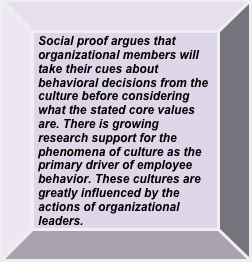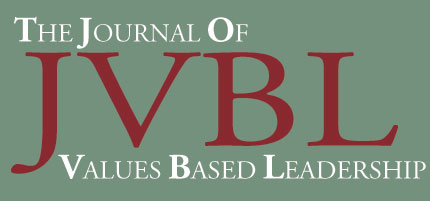- CONTENTS:
- Letter from the EditorTable of Contents"Smart"Change in Strategy: IBM’s Response to Challenging Times IBM and the Future: Building a Smarter PlanetOliver Winery and the Recipe for Values-Based Leadership: People, Product and PlaceHolistic Leadership: A Model for Leader-Member Engagement and Development A Tale of Two Cultures: Why Culture Trumps Core Values in Building Ethical OrganizationsLeadership: The Tabletop Concept The Leader as Moral Agent: Praise, Blame, and the Artificial Person

- A TALE OF TWO CULTURES: WHY CULTURE TRUMPS CORE VALUES IN BUILDING ETHICAL ORGANIZATIONS
Introduction

David Burkus
Regent University
Virginia Beach ,VAThis paper examines the influence of organizational culture on ethical behavior by considering two separate corporate case studies: Enron and Zappos. Research shows that organizational culture is a primary driver in employee behavior and that leaders shape this behavior. Despite Enron’s statement of its core ethical values, senior leadership actions created a culture of greed that encouraged unethical behavior at all levels. In contrast, Zappos has become renowned for its ethical culture. Readers will learn the importance of alignment between culture and core values as well as how to assess whether an organization’s culture will support its statement of core values.
 The Enron Backdrop
The Enron Backdrop A Houston courtroom served as the scene for one of the more famous trials of the past decade: the trial of Enron CEO Jeffrey Skilling. From the beginning of his trial through to his sentencing in May of 2006, Skilling maintained his innocence (Gladwell, 2006). During the trial, prosecutors and defenders examined witnesses and experts and presented a host of evidence. However, it was the evidence presented in the court of public opinion that may be remembered the most. Among the ammunition used by journalists and commentators was a company-produced book: the Enron Code of Ethics Manual. The Code of Ethics went beyond a few choice words framed and hung on a wall in the lobby. This 64-page manual not only outlined the company’s mission and core values, but also the various ethical policies that all employees were expected to follow (Enron, 2000).
Many companies draft core values handbooks and manuals. Most that provide instruction on how to create a core values statement call for senior leadership teams to conduct off-site meetings and compile their ideas about the precise wording of those core values (see Collins & Porras, 1996 for a typical sample). Many times these statements are used as the foundation for organization-wide training programs in the hope of transferring these words into the actions of employees (Patterson, 2010). This is how a simple statement of core values can grow into a 64-page ethics manual so detailed that one begins to wonder how it failed to prevent the scandal that befell Enron.
The Role of Culture
When looking at ethics in organizations, one cannot merely consider core values statements and ignore social proof (Cialdini, 1993). People typically do not look to written codes for clues about how to behave; they look to others. For an example closer to home, consider speed limits. Few people actually limit their speed to the 55 or 65 miles per hour posted on highway signs. Instead, most drive a set speed over the limit (“5 over” or “10 over”) depending on the culture of the area. In organizations, employees often decide how to act not based upon an ethical statement on the company intranet or in a policy manual, but by how they see others acting.
Within an organizational setting, there is a growing body of literature demonstrating how culture and climate are crucial to understanding how unethical cultures facilitate unethical and even illegal activity (Trevino, Butterfield & McCabe, 1998; Dickson, Smith, Grojean & Ehrhart, 2001). The ethical culture of organizations has been shown to influence the process and judgment dimension of integrity (Barnett & Varcys, 2000). Incidents of unethical behavior, therefore, often are partially explained by organizational culture (Sinclair, 1993). These incidents help to explain the behavior but also help to shape a culture that influences future incidents, thus creating a cycle of unethical behavior.
Wimbush, Shepard and Markham (1997) examined the link between ethical climate and integrity. The researchers surveyed 525 employees in a national retail, sales-commissioned organization. Ethical climate was assessed using Victor and Cullen’s (1987) Ethical Climate Questionnaire (ECQ), a 36-item questionnaire used to measure the various dimensions of an ethical climate (the independent variable). Factor analysis determined five factors or types of ethical climate – independence, caring, instrumental law, rules, and service. Ethical behavior (the dependent variable) was measured using vignettes from the Work Situation Questionnaire (WSQ) (Shepard and Hartenian, 1991). The WSQ presents four ethical vignettes derived from newspaper reports of actual ethical situations experienced by business organizations. The four ethical dilemmas covered stealing, lying, disobeying company policies, and serving as an accomplice. Regression analysis was performed for each of the five dimensions and for each of the four dependent variables. Overall, the presence of ethical climate was negatively related to unethical behavior (Wimbush, Shepard, and Markham, 1997). Most regressions were negative and significant (See Table 1 for full summary). Five nonsignificant negative relationships and three nonsignificant positive relationships were discovered. The only positive, significant relationship was founded between instrumental climate and serving as an accomplice (all of the relationships for instrumental climate were positive, though the remaining were nonsignificant). Instrumental climates are marked by employees expected to sacrifice work and personal morals for the good of the company (Victor and Cullen, 1987).
Table 1: Relationship between ethical climate and behavior*
*Reprinted with permission. (Wimbush, Shepard & Markham, 1997).
Wumbush, Shepard and Markham’s (1997) results suggest there is a relationship between the ethical climate of an organization and the ethical decisions its employees make. An organization that has shaped an ethical climate and culture should be less likely to house unethical behaviors. The values and behavior of senior leadership is especially influential in shaping organizational culture (Dickson, Smith, Grojean & Ehrhart, 2001). Schein (1985) outlines five primary behaviors that serve as mechanisms leaders use to create and reinforce organizational culture:
- Attention focusing;
- Reaction to crises;
- Role-modeling;
- Rewards allocation; and
- Hiring/firing criteria.
In a case study of the Enron collapse, Sims and Brinkman (2003), demonstrate how Enron’s senior leaders’ actions related to all five mechanisms assisted in creating the unethical culture that caused Enron’s demise.
The Enron Culture
At its peak, Enron was an energy, commodities, and services company employing nearly 22,000 people (McLean & Elkind, 2004). Based in Houston, Texas, Enron was one of the largest energy companies in the world and had been named “America’s most innovative company” for six consecutive years by Fortune magazine. Enron was founded in 1985 in Omaha, Nebraska as a natural gas provider, but was reorganized in 1979 to function as a holding company (BBC News, n.d.). The company was regarded as a competitive, talent-focused culture where “stars” were lavishly rewarded and permitted to launch new projects, often without supervision (Gladwell, 2002).
In its annual report to shareholders, Enron listed its core values as follows:
- Communication – We have an obligation to communicate.
- Respect – We treat others as we would like to be treated.
- Integrity – We work with customers and prospects openly, honestly, and sincerely.
- Excellence– We are satisfied with nothing less than the very best in everything we do. (Enron, Annual Report, 2000, p. 29).
However, several examples reveal that the culture stood opposed to these core values. Instead of reinforcing the code of ethics and the list of virtuous core values, the actions of leadership established a culture with values of greed and pride. While the printed code of ethics described the company’s commitment to “conducting the business affairs of the companies in accordance with all applicable laws and in a moral and honest manner” (Enron, 2000, p. 5) and espoused the virtues of integrity and respect as core values, the behaviors and attitudes of its people often stood on the opposing pole.
Two examples of unethical behavior among leadership best demonstrate how Enron’s culture was established and strengthened. Former Enron CEO Jeffrey Skilling was inspired by one of his favorite books, The Selfish Gene, (Dawkins, 1976) to establish a grading system for all employees, routinely firing those who failed to help meet the company’s performance objectives (McLean & Elkind, 2004). However, the culture of greed is better seen in the actions taken by Andrew Fastow, former Enron Chief Financial Officer and one of the company’s board of directors. In an effort to continue to build revenue on Enron’s balance sheet, Fastow undertook an elaborate process of establishing special partnerships to bundle assets and secure loans (Gladwell, 2006). The board of Enron, understanding that Fastow’s involvement in these partnerships was a violation of its code of ethics, voted to suspend the code of ethics’ application to Fastow while these partnerships were active (Berenheim, 2002). Fastow’s actions and the board’s decision were not kept private, as SEC regulations required the identities of these partnership members to be disclosed.
These actions undoubtedly helped shape the culture of Enron. Taking these two examples into consideration, it becomes clear why reports of unethical behavior were seen at all levels. Consider the reports of former energy traders for Enron who reported boasting between traders during the California blackouts about the various tactics used to decrease supply or increase demand for energy and hence, increase the price of energy (McLean & Elkind, 2004). Despite public awareness about the dangers of this behavior, no one came forth to speak out against it. Some former Enron employees labeled the strength of the unethical culture as akin to groupthink (Stephens & Behr, 2002, A01). While senior leadership worked to create a statement of core values that upheld the highest ethical standards, their actions shaped a culture that would not meet these standards.
The Zappos Culture
Despite its young age, online shoe retailer Zappos has received a seemingly disproportionate amount of media attention regarding its unique corporate culture (O’Brien, 2009; Chafkin, 2009; Pershcel, 2010). However, this attention is well deserved, as Zappos is considered by many to be a shining example of customer service, culture, and ethics (Chafkin, 2009).
Zappos was founded in 1999. It has since expanded its product offerings to clothing, accessories, and even various overstocked merchandise through its subsidiary companies (Hsieh, 2010). Compared to Enron, the company is small, employing approximately 2,000 people at its headquarters in Las Vegas, Nevada and in its warehouse in Kentucky. Zappos does not just differ in size; it differs drastically in its business paradigm as well. The company places its emphasis on developing its culture and core values around the happiness of both its employees and its customers (Hsieh, 2010). Though not publicly cited by Hsieh or anyone in the Zappos leadership team, the business philosophy of the company appears greatly aligned with Heskett, Sasser, and Schlesinger’s (1997) service profit chain; the concept that when a company puts emphasis on employee and customer satisfaction, profit follows invariably (Heskett, et. al, 1994).
It is surprising to learn that the company lacked a formal statement of core values for the first six years of its existence (Hsieh, 2010). Zappos CEO Tony Hsieh believed that writing out core values was too corporate and ineffective. Hsieh was familiar with the offsite retreat homework assignment used by most corporations and did not want to draft a document that failed to reflect the true culture of his employees. Instead, Tony focused first on creating a dignified company culture: one that was committed to exceptional customer experiences (Hsieh, 2010). Hsieh even reinforced this culture by drafting a book of essays about company cultures comprised entirely of employee contributions (Chafkin, 2009). Zappos eventually developed training programs designed to reinforce this internal framework (Hsieh, 2010). Hsieh has even gone so far as to offer to pay employees to quit if they are not a cultural fit (Taylor, 2008).
It was Zappos employees who eventually persuaded Hsieh that they needed a statement of values to represent the Zappos environment (Hseih, 2010). Instead of taking his senior executives off-site to prepare such a statement, Hsieh borrowed the strategy used to create the culture book. Hsieh emailed everyone in the company, asking for their input on what they believed were the core values of Zappos (Chafkin, 2009). Then, like a gardener tending to plants, he pruned and watered certain ideas, combining similar values and expanding on others (Hseih, 2010). Finally, they settled on ten core values, which remain unchanged even today:
- Deliver WOW Through Service.
- Embrace and Drive Change.
- Create Fun and a Little Weirdness.
- Be Adventurous, Creative, and Open-Minded.
- Pursue Growth and Learning.
- Build Open and Honest Relationships With Communication.
- Build a Positive Team and Family Spirit.
- Do More With Less.
- Be Passionate and Determined.
- Be Humble (Hsieh, 2010, p. 154).
Once these foundational values were identified, Hsieh knew they had to take root within the organization (Chafkin, 2009). The human resources department eventually would create interview questions to examine candidates' positions on each of these principles (Hsieh, 2010). Once hired, new employees are required to read and sign a statement of acknowledgement, indicating their understanding and acceptance of the company's core values.
It is important to note that Zappos leadership did not lead with a statement of core values. Instead, Hsieh created and reinforced a culture that held these values, and let employees themselves declare it. In this way, Zappos leadership not only created a list of values that employees believed in, but also leveraged the power of social proof to ensure that employees acted on what they believe. The strength of their beliefs would be put to the test on May 21, 2010, when a computer glitch developed on 6pm.com, a Zappos-owned bargain retailer. A flaw in the website caused the price of every product on the site to be reset to $49.95 (Albanesis, 2010). Within six hours of discovering the error, Zappos employees had fixed the glitch. Then Zappos’ Director of Brand Marketing and Business Development made the announcement on the company’s blog: Zappos would honor every transaction (Magness, 2010). This decision would cost Zappos over $1.6 million (Albanesis, 2010). However, it would also serve as another example of how Zappos sought to stay true to its culture and core values and deliver “WOW through customer service” (Hsieh, 2010, p. 154).
Conclusion
The business world has witnessed no shortage of ethical scandals in recent years. In the wake of these, one often begins to wonder how companies that profess a commitment to ethical core values can be guilty of such blatant ethical violations. Social proof argues that organizational members will take their cues about behavioral decisions from the culture before identifying their stated core values. There is growing research support for the phenomena of culture as the primary driver of employee behavior. These cultures are greatly influenced by the actions of organizational leaders. In the case of Enron, despite an ethical statement of values and a lengthy company code of ethics, senior leadership’s actions encouraged unethical behavior at all levels. In contrast, Zappos has become renowned for its culture and customer service. The core values at Zappos were drawn from this culture and the actions of leaders at all levels have strengthened it. Even when challenged by a $1.6 million mistake, Zappos remained committed to delivering on its promises and its core values.
These cases suggest to organizational leaders the need to consider culture as central to building an ethical organization. Misalignment between core values, organizational culture, and leadership behavior can void any desired, positive affect from stating core values. When drafting or promoting statements of core values, leaders ought to first consider whether the culture of the organization will support such statements. Culture audit surveys such as Cameron and Quinn’s (2006) Organizational Culture Assessment Inventory provide useful tools for assessing the current and aspired-to culture of an organization, and discovering ways to strengthen the positive aspects of that culture. In this way, leaders can ensure that their virtuous culture supports their virtuous core values. ________________________________________________________________________________________
ReferencesAlbanesis, C. (2010, May 24). Zappos-owned 6pm.com glitch prices everything at $50. Retrieved from http://www.pcmag.com/article2/0,2817,2364117,00.asp.
Barnett, T. & Varcys, C. (2000). The moderating effect of individuals’ perceptions of ethical work climate on ethical judgments and behavioral intentions. Journal of Business Ethics, 27(4), 351-362.
BBC News. (n.d.). Enron: timeline. Retrieved January 1, 2011 from http://news.bbc.co.uk/hi/english/static/in_depth/business/2002/enron/timeline/.
Cameron, K. S., & Quinn, R. E. (2006). Diagnosing and changing organizational culture: Based on the competing values framework (Rev. ed.). San Francisco: Jossey-Bass.
Chafkin, M. (2009). Get happy. Inc., 31(4), 66-73.
Cialdini, R. (1993). Influence: Science and practice (3rd ed.). New York: HarperCollins.
Collins, J.C. & Porras, J.I. (1996). Building your company’s vision. Harvard Business Review, 74(5), 65-77.
Dawkins, R. (1976). The Selfish Gene. New York: Oxford University Press.
Dickson, M., Smith, D., Grojean, M. & Ehrhart, M. (2001). An organizational climate regarding ethics: The outcome of leader values and the practices that reflect them. Leadership Quarterly, 12(2), 197-217.
Enron. (2000). Enron Code of Ethics.
Enron. (2000). Enron Corporation 2000 Annual Review to Shareholders. Gladwell, M. (2002, July 22). The talent myth: Are smart people overrated. The New Yorker, 28-33.
Gladwell, M. (2007, January 8). Open secrets: Enron, intelligence and the perils of too much information. The New Yorker. Retrieved January 1, 2011 from http://www.newyorker.com/reporting/2007/01/08/070108fa_fact.
Heskett, J.L., Sasser, W.E. & Schlesinger, L.A. (1997). The service profit chain: how leading companies link profit and growth to loyalty, satisfaction and value. New York, NY: Free Press.
Heskett, J.L., Jones, T.O., Loveman, G.W. Sasser, W.E., & Schlesinger, L.A. (1994). Putting the service profit chain to work. Harvard Business Review, 72(2), 164-170.
Hsieh, T. (2010). Delivering happiness: A path to profits, passion and purpose. New York: Business Plus.
Magnuss, A. (2010). 6pm.com pricing mistake. Retrieved from http://blogs.zappos.com/blogs/inside-zappos/2010/05/21/6pm-com-pricing-mistake.
McLean, B. & Elkind, P. (2004). Enron: The smartest guys in the room. New York: Portfolio Trade.
O’Brien, J. (2009). Zappos knows how to kick it. Fortune, 159(2), 54-60.Patterson, K. (2010). Why learning is never enough. Chief Learning Officer, 9(5), 28-31.
Perschel, A. (2010). Work-life flow: How individuals, Zappos and other innovative companies achieve high engagement. Global Business & Organizational Excellence, 29(5), 17-30.
Schein, E. (1985). Organizational Culture and Leadership. San Francisco: Jossey-Bass.
Shepard, J.M. & Hartenian, L. (1991). Egoistic and ethical orientations of university students toward work-
related decisions. Journal of Business Ethics, 10(4), 303-310.Sims, R. R. & Brinkman, J. (2003). Enron ethics (or: Culture matters more than codes). Journal of Business Ethics, 45(3), 243-256.
Sinclair, A. (1993). Approaches to organizational culture and ethics. Journal of Business Ethics, 12(1), 63-73.
Stephens, J. & Behr, P. (2002, January 27). Enron’s culture fed its demise: Groupthink promoted foolhardy risks. Washington Post, A01.
Taylor, B. (2008, May 19). Why Zappos pays new employees to quit–and you should too. Retrieved Jan. 1, 2001 from http://blogs.hbr.org/taylor/2008/05/why_zappos_pays_new_employees.html.
Trevino, L., Butterfield, K., & McCabe, D. (1998). The ethical context in organizations; Influences on employee attitudes and behavior. Business Ethics Quarterly, 8(3), 447-476.
Victor, B. and Cullen, J. (1987). A theory and measure of ethical climate in organizations. Research in Corporate Social Performance and Policy, 9, 51-71.
Wimbush, J., Shepard, J., & Markham, S. (1997). An empirical examination of the relationship between ethical climate and ethical behavior from multiple levels of analyses. Journal of Business Ethics, 16(16), 1705-1716.
________________________________________________________________________________________
Author Biography
David Burkus is the editor of LeaderLab, a community of resources dedicated to promoting the practice of leadership theory. He is a consultant, a speaker, and an adjunct professor of business at several universities. David is a graduate of Oral Roberts University and holds a Master of Arts in Organizational Dynamics from the University of Oklahoma. David is currently pursuing a Doctorate of Strategic Leadership from Regent University. He can be reached at david@davidburkus.com.

